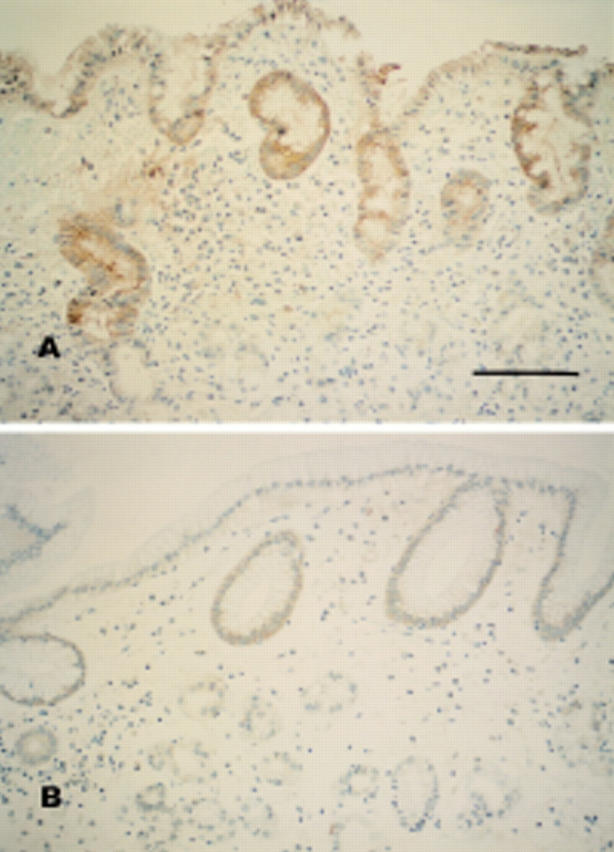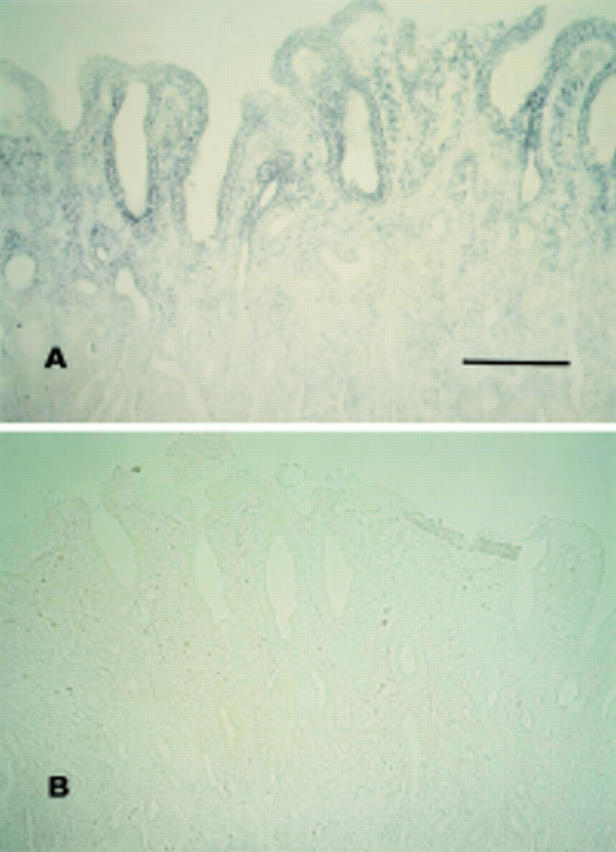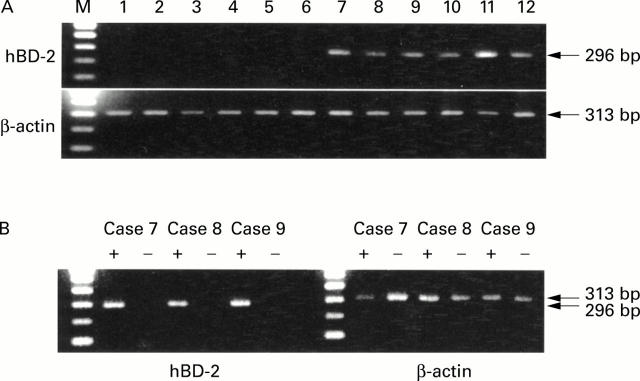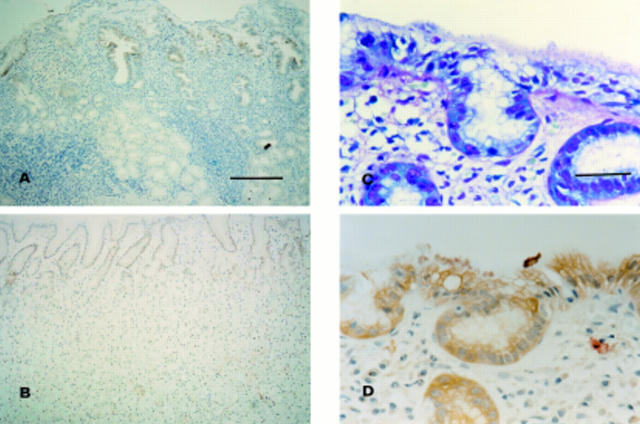Abstract
BACKGROUND—Human β-defensin 2 (hBD-2) plays a role in the innate defence system at mucosal surfaces. Colonisation of Helicobacter pylori in the stomach is an important pathological factor in gastrointestinal illnesses, including gastritis, peptic ulcer, and gastric adenocarcinoma. AIMS—To evaluate the antibacterial role of hBD-2 against H pylori infection in the gastric mucosa. SUBJECTS—Biopsied gastric mucosa specimens from H pylori positive (n=6) and H pylori negative (n=6) individuals were used. H pylori was determined by the presence of urease activity and microscopic examination. METHODS—The specimens were examined for hBD-2 expression by reverse transcription-polymerase chain reaction (RT-PCR), immunohistochemistry, and in situ hybridisation. The antibacterial effect of hBD-2 against H pylori was evaluated by the number of colony forming units of H pylori after incubation with 0, 10−9, 10−8, 10−7, 10−6, or 10−5 M of hBD-2 peptide. RESULTS—All six H pylori positive specimens expressed a high level of hBD-2 mRNA while hBD-2 mRNA was not detected in the H pylori negative specimens by RT-PCR. Immunohistochemistry using anti-hBD-2 antiserum revealed that hBD-2 was expressed in the surface epithelium of H pylori infected specimens. In gastric specimens obtained after H pylori eradication, hBD-2 immunoreactivity had dramatically decreased. In situ hybridisation confirmed that hBD-2 transcripts were localised in the epithelium of H pylori infected gastric specimens. Incubation with hBD-2 reduced the growth rate of cultured H pylori in a dose dependent manner, and incubation with 10−5 M hBD-2 completely inhibited the proliferation of H pylori. CONCLUSIONS—H pylori infection induces hBD-2 expression in the human gastric epithelium. hBD-2 inhibited the growth of H pylori in vitro, suggesting that hBD-2 plays an antibacterial role in H pylori induced gastritis. Keywords: human β-defensin 2; Helicobacter pylori; gastritis; antimicrobial peptide
Full Text
The Full Text of this article is available as a PDF (258.2 KB).
Figure 1 .
Reverse transcription-polymerase chain reaction (RT-PCR) analysis of human β-defensin 2 (hBD-2) expression in gastric mucosa specimens. (A) Lanes 1-12 correspond to gastric specimens obtained from cases 1-12, respectively, in table 1. Cases 1-6 were not infected with Helicobacter pylori and cases 7-12 were infected with H pylori. (B) Expression of hBD-2 mRNA in gastric mucosa specimens obtained from cases 7-9 before and after H pylori eradication. Cases 7-9 in table 1 were applicable in this experiment. +, before H pylori eradication; −, after H pylori eradication; M, 100 bp DNA ladder as a marker.
Figure 2 .
Immunohistochemical analysis of human β-defensin 2 (hBD-2) expression in gastric mucosa specimens with (case 9) (A) or without (case 3) (B) Helicobacter pylori colonisation. Both (A) and (B) have the same magnification. The scale bar in (A) represents 200 µm. (C) May-Giemsa stained section adjacent to (D) and demonstrating colonisation of H pylori at the mucosal surface (case 9). (D) Immunoreactivity for hBD-2 in gastric epithelium at a high magnification can be seen. The scale bar in (C) represents 800 µm.
Figure 3 .

Immunohistochemical analysis of human β-defensin 2 (hBD-2) expression in gastric mucosa specimens obtained before (A) and after (B) Helicobacter pylori eradication in case No 7. (A) and (B) have the same magnification. The scale bar in (A) represents 200 µm.
Figure 4 .

In situ hybridisation of human β-defensin 2 (hBD-2) mRNA in Helicobacter pylori infected gastric mucosa specimens. (A) A hybridisation signal with the hBD-2 antisense probe was predominantly observed in the surface epithelium and pits, and also in the inflammatory cells scattered in the interstitium (case 12). The full length hBD-2 antisense probe may cross react with hBD-1 as a leucocytic defensin because the open frame of hBD-2 cDNA shows 39% identity with hBD-1.34 (B) No signals were detected on hybridisation with the hBD-2 sense probe as a negative control (case 12). (A) and (B) have the same magnification. The scale bar in (A) represents 100 µm.
Figure 5 .

Antimicrobial effect of synthetic human β-defensin 2 (hBD-2) peptides on Helicobacter pylori colony formation in an in vitro assay. Each bar represents mean (SEM). CFU, colony forming units.
Selected References
These references are in PubMed. This may not be the complete list of references from this article.
- Aihara M., Tsuchimoto D., Takizawa H., Azuma A., Wakebe H., Ohmoto Y., Imagawa K., Kikuchi M., Mukaida N., Matsushima K. Mechanisms involved in Helicobacter pylori-induced interleukin-8 production by a gastric cancer cell line, MKN45. Infect Immun. 1997 Aug;65(8):3218–3224. doi: 10.1128/iai.65.8.3218-3224.1997. [DOI] [PMC free article] [PubMed] [Google Scholar]
- Ainpour P. R., Wickstrom E. Modifications of solid phase peptide synthesis to obtain homogeneous oligoprolines in high yield. Int J Pept Protein Res. 1980 Mar;15(3):225–235. doi: 10.1111/j.1399-3011.1980.tb02571.x. [DOI] [PubMed] [Google Scholar]
- Ball H. L., Mascagni P. Chemical synthesis and purification of proteins: a methodology. Int J Pept Protein Res. 1996 Jul;48(1):31–47. doi: 10.1111/j.1399-3011.1996.tb01104.x. [DOI] [PubMed] [Google Scholar]
- Bals R., Wang X., Wu Z., Freeman T., Bafna V., Zasloff M., Wilson J. M. Human beta-defensin 2 is a salt-sensitive peptide antibiotic expressed in human lung. J Clin Invest. 1998 Sep 1;102(5):874–880. doi: 10.1172/JCI2410. [DOI] [PMC free article] [PubMed] [Google Scholar]
- Bensch K. W., Raida M., Mägert H. J., Schulz-Knappe P., Forssmann W. G. hBD-1: a novel beta-defensin from human plasma. FEBS Lett. 1995 Jul 17;368(2):331–335. doi: 10.1016/0014-5793(95)00687-5. [DOI] [PubMed] [Google Scholar]
- Bevins C. L., Martin-Porter E., Ganz T. Defensins and innate host defence of the gastrointestinal tract. Gut. 1999 Dec;45(6):911–915. doi: 10.1136/gut.45.6.911. [DOI] [PMC free article] [PubMed] [Google Scholar]
- Blaser M. J. Helicobacter pylori and gastric diseases. BMJ. 1998 May 16;316(7143):1507–1510. doi: 10.1136/bmj.316.7143.1507. [DOI] [PMC free article] [PubMed] [Google Scholar]
- Blaser M. J. Hypotheses on the pathogenesis and natural history of Helicobacter pylori-induced inflammation. Gastroenterology. 1992 Feb;102(2):720–727. doi: 10.1016/0016-5085(92)90126-j. [DOI] [PubMed] [Google Scholar]
- Censini S., Lange C., Xiang Z., Crabtree J. E., Ghiara P., Borodovsky M., Rappuoli R., Covacci A. cag, a pathogenicity island of Helicobacter pylori, encodes type I-specific and disease-associated virulence factors. Proc Natl Acad Sci U S A. 1996 Dec 10;93(25):14648–14653. doi: 10.1073/pnas.93.25.14648. [DOI] [PMC free article] [PubMed] [Google Scholar]
- Chomczynski P., Sacchi N. Single-step method of RNA isolation by acid guanidinium thiocyanate-phenol-chloroform extraction. Anal Biochem. 1987 Apr;162(1):156–159. doi: 10.1006/abio.1987.9999. [DOI] [PubMed] [Google Scholar]
- Diamond G., Bevins C. L. beta-Defensins: endogenous antibiotics of the innate host defense response. Clin Immunol Immunopathol. 1998 Sep;88(3):221–225. doi: 10.1006/clin.1998.4587. [DOI] [PubMed] [Google Scholar]
- Dixon M. F., Genta R. M., Yardley J. H., Correa P. Classification and grading of gastritis. The updated Sydney System. International Workshop on the Histopathology of Gastritis, Houston 1994. Am J Surg Pathol. 1996 Oct;20(10):1161–1181. doi: 10.1097/00000478-199610000-00001. [DOI] [PubMed] [Google Scholar]
- Dunn B. E., Campbell G. P., Perez-Perez G. I., Blaser M. J. Purification and characterization of urease from Helicobacter pylori. J Biol Chem. 1990 Jun 5;265(16):9464–9469. [PubMed] [Google Scholar]
- Eaton K. A., Brooks C. L., Morgan D. R., Krakowka S. Essential role of urease in pathogenesis of gastritis induced by Helicobacter pylori in gnotobiotic piglets. Infect Immun. 1991 Jul;59(7):2470–2475. doi: 10.1128/iai.59.7.2470-2475.1991. [DOI] [PMC free article] [PubMed] [Google Scholar]
- Harder J., Bartels J., Christophers E., Schröder J. M. A peptide antibiotic from human skin. Nature. 1997 Jun 26;387(6636):861–861. doi: 10.1038/43088. [DOI] [PubMed] [Google Scholar]
- Harder J., Meyer-Hoffert U., Teran L. M., Schwichtenberg L., Bartels J., Maune S., Schröder J. M. Mucoid Pseudomonas aeruginosa, TNF-alpha, and IL-1beta, but not IL-6, induce human beta-defensin-2 in respiratory epithelia. Am J Respir Cell Mol Biol. 2000 Jun;22(6):714–721. doi: 10.1165/ajrcmb.22.6.4023. [DOI] [PubMed] [Google Scholar]
- Hiratsuka T., Nakazato M., Date Y., Ashitani J., Minematsu T., Chino N., Matsukura S. Identification of human beta-defensin-2 in respiratory tract and plasma and its increase in bacterial pneumonia. Biochem Biophys Res Commun. 1998 Aug 28;249(3):943–947. doi: 10.1006/bbrc.1998.9239. [DOI] [PubMed] [Google Scholar]
- Imajoh-Ohmi S., Tokita K., Ochiai H., Nakamura M., Kanegasaki S. Topology of cytochrome b558 in neutrophil membrane analyzed by anti-peptide antibodies and proteolysis. J Biol Chem. 1992 Jan 5;267(1):180–184. [PubMed] [Google Scholar]
- King D. S., Fields C. G., Fields G. B. A cleavage method which minimizes side reactions following Fmoc solid phase peptide synthesis. Int J Pept Protein Res. 1990 Sep;36(3):255–266. doi: 10.1111/j.1399-3011.1990.tb00976.x. [DOI] [PubMed] [Google Scholar]
- Lindholm C., Quiding-Järbrink M., Lönroth H., Hamlet A., Svennerholm A. M. Local cytokine response in Helicobacter pylori-infected subjects. Infect Immun. 1998 Dec;66(12):5964–5971. doi: 10.1128/iai.66.12.5964-5971.1998. [DOI] [PMC free article] [PubMed] [Google Scholar]
- Liu F. T., Zinnecker M., Hamaoka T., Katz D. H. New procedures for preparation and isolation of conjugates of proteins and a synthetic copolymer of D-amino acids and immunochemical characterization of such conjugates. Biochemistry. 1979 Feb 20;18(4):690–693. doi: 10.1021/bi00571a022. [DOI] [PubMed] [Google Scholar]
- Liu L., Wang L., Jia H. P., Zhao C., Heng H. H., Schutte B. C., McCray P. B., Jr, Ganz T. Structure and mapping of the human beta-defensin HBD-2 gene and its expression at sites of inflammation. Gene. 1998 Nov 19;222(2):237–244. doi: 10.1016/s0378-1119(98)00480-6. [DOI] [PubMed] [Google Scholar]
- Marshall B. J., Warren J. R. Unidentified curved bacilli in the stomach of patients with gastritis and peptic ulceration. Lancet. 1984 Jun 16;1(8390):1311–1315. doi: 10.1016/s0140-6736(84)91816-6. [DOI] [PubMed] [Google Scholar]
- Mattsson A., Lönroth H., Quiding-Järbrink M., Svennerholm A. M. Induction of B cell responses in the stomach of Helicobacter pylori- infected subjects after oral cholera vaccination. J Clin Invest. 1998 Jul 1;102(1):51–56. doi: 10.1172/JCI22. [DOI] [PMC free article] [PubMed] [Google Scholar]
- McNAMARA N. A., Van R., Tuchin O. S., Fleiszig S. M. Ocular surface epithelia express mRNA for human beta defensin-2. Exp Eye Res. 1999 Nov;69(5):483–490. doi: 10.1006/exer.1999.0722. [DOI] [PubMed] [Google Scholar]
- Mori N., Wada A., Hirayama T., Parks T. P., Stratowa C., Yamamoto N. Activation of intercellular adhesion molecule 1 expression by Helicobacter pylori is regulated by NF-kappaB in gastric epithelial cancer cells. Infect Immun. 2000 Apr;68(4):1806–1814. doi: 10.1128/iai.68.4.1806-1814.2000. [DOI] [PMC free article] [PubMed] [Google Scholar] [Retracted]
- Münzenmaier A., Lange C., Glocker E., Covacci A., Moran A., Bereswill S., Baeuerle P. A., Kist M., Pahl H. L. A secreted/shed product of Helicobacter pylori activates transcription factor nuclear factor-kappa B. J Immunol. 1997 Dec 15;159(12):6140–6147. [PubMed] [Google Scholar]
- Nagata H., Wada A., Kurazono H., Yahiro K., Shirasaka D., Ikemura T., Aoyama N., Wang A. P., Makiyama K., Kohno S. Application of Bead-ELISA method to detect Helicobacter pylori VacA. Microb Pathog. 1999 Feb;26(2):103–110. doi: 10.1006/mpat.1998.0256. [DOI] [PubMed] [Google Scholar]
- Pütsep K., Brändén C. I., Boman H. G., Normark S. Antibacterial peptide from H. pylori. Nature. 1999 Apr 22;398(6729):671–672. doi: 10.1038/19439. [DOI] [PubMed] [Google Scholar]
- Schnapp D., Reid C. J., Harris A. Localization of expression of human beta defensin-1 in the pancreas and kidney. J Pathol. 1998 Sep;186(1):99–103. doi: 10.1002/(SICI)1096-9896(199809)186:1<99::AID-PATH133>3.0.CO;2-#. [DOI] [PubMed] [Google Scholar]
- Schröder J. M., Harder J. Human beta-defensin-2. Int J Biochem Cell Biol. 1999 Jun;31(6):645–651. doi: 10.1016/s1357-2725(99)00013-8. [DOI] [PubMed] [Google Scholar]
- Singh P. K., Jia H. P., Wiles K., Hesselberth J., Liu L., Conway B. A., Greenberg E. P., Valore E. V., Welsh M. J., Ganz T. Production of beta-defensins by human airway epithelia. Proc Natl Acad Sci U S A. 1998 Dec 8;95(25):14961–14966. doi: 10.1073/pnas.95.25.14961. [DOI] [PMC free article] [PubMed] [Google Scholar]
- Tarver A. P., Clark D. P., Diamond G., Russell J. P., Erdjument-Bromage H., Tempst P., Cohen K. S., Jones D. E., Sweeney R. W., Wines M. Enteric beta-defensin: molecular cloning and characterization of a gene with inducible intestinal epithelial cell expression associated with Cryptosporidium parvum infection. Infect Immun. 1998 Mar;66(3):1045–1056. doi: 10.1128/iai.66.3.1045-1056.1998. [DOI] [PMC free article] [PubMed] [Google Scholar]
- Tummuru M. K., Sharma S. A., Blaser M. J. Helicobacter pylori picB, a homologue of the Bordetella pertussis toxin secretion protein, is required for induction of IL-8 in gastric epithelial cells. Mol Microbiol. 1995 Dec;18(5):867–876. doi: 10.1111/j.1365-2958.1995.18050867.x. [DOI] [PubMed] [Google Scholar]
- Valore E. V., Park C. H., Quayle A. J., Wiles K. R., McCray P. B., Jr, Ganz T. Human beta-defensin-1: an antimicrobial peptide of urogenital tissues. J Clin Invest. 1998 Apr 15;101(8):1633–1642. doi: 10.1172/JCI1861. [DOI] [PMC free article] [PubMed] [Google Scholar]
- Wada A., Mori N., Oishi K., Hojo H., Nakahara Y., Hamanaka Y., Nagashima M., Sekine I., Ogushi K., Niidome T. Induction of human beta-defensin-2 mRNA expression by Helicobacter pylori in human gastric cell line MKN45 cells on cag pathogenicity island. Biochem Biophys Res Commun. 1999 Oct 5;263(3):770–774. doi: 10.1006/bbrc.1999.1452. [DOI] [PubMed] [Google Scholar]
- Wyatt J. I., Rathbone B. J. Immune response of the gastric mucosa to Campylobacter pylori. Scand J Gastroenterol Suppl. 1988;142:44–49. [PubMed] [Google Scholar]





